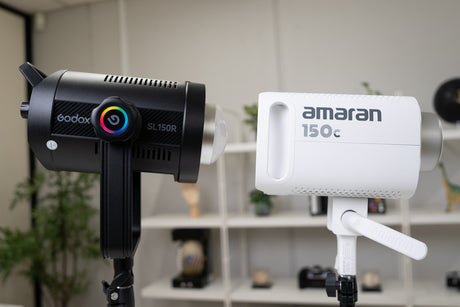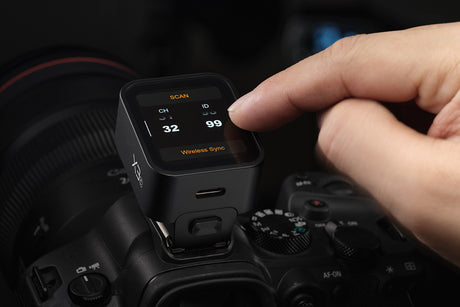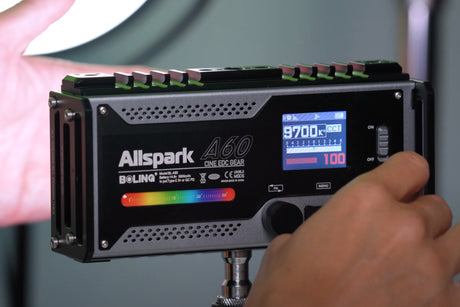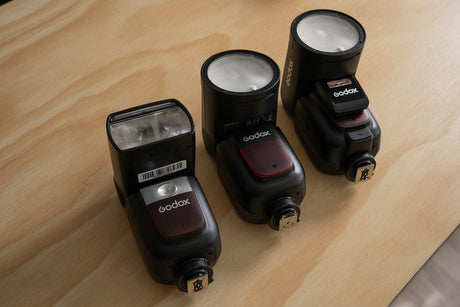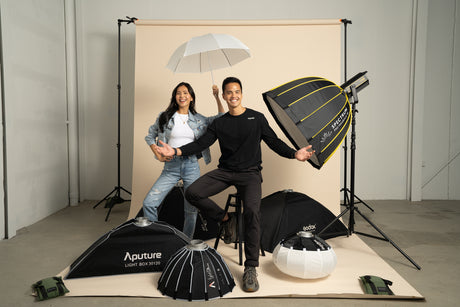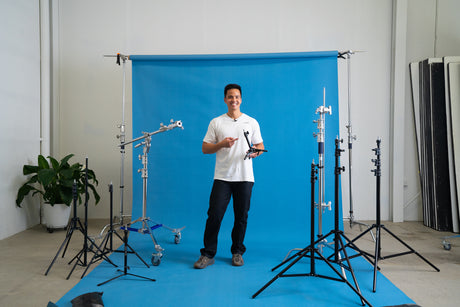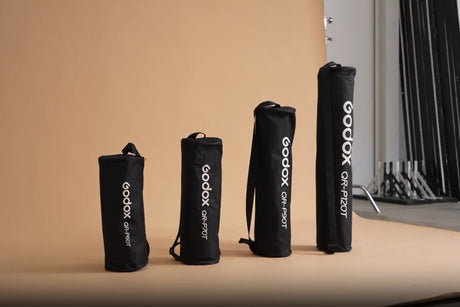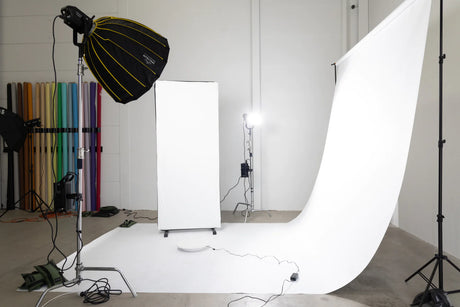Based on the number of Instagram accounts dedicated to food, it’s obvious that people enjoy looking at tasty snacks and meals as much as they like eating them! Whether you are an influencer with a smartphone or a professional photographer creating images for a recipe book, a stunning backdrop will add an extra dimension of style and charm to your food photography. These days, you don’t have to scout around for kitchen benchtops that suit the type of food photography you wish to shoot. You can purchase a wide range of backgrounds and use them in the comfort of your studio. The most popular forms of backgrounds are flat lays, muslin backdrops, and paper rolls. In this flat lay and backdrop comparison guide, we’ll explore the advantages of each type of material for photography and videography.
Flat Lays

When images are taken from directly above, it’s called flat lay photography, and it has become extremely popular amongst the Foodies of Instagram. For this style of photo, you need a staging ground for the food you are presenting. From colourful cupcakes to an Italian feast, having the appropriate flat lay backdrop under the food adds to its appeal. At Hypop, we have an assortment of non-reflective flat lays that look like tiled walls, marble benchtops, and wooden tables to provide variety and texture to the background of your food photography.
Plain white backgrounds are acceptable for product photography, but to create a hunger for the food you present requires the addition of emotion. By incorporating props and the appearance of a natural environment, you involve the viewer in the scene. For example, using a flat lay of pink tiles behind sweet treats creates the illusion of a bright, fun-filled café, whereas whitewashed wooden boards under a plate bring to mind the dining room of a rustic farmhouse.
Lifestyle photography becomes easy with stylish backdrops such as these realistic yet smooth flat lay backdrops. Their generous size (56cm x 87cm) is suitable for one or two plates of food at a time. Unroll one of the designs for a base, and tape another to the wall to give dishes of cookies, bowls of soup or a cake on a stand some instant ‘wow’ factor. If you need more room, simply rest them against each other to extend your shooting area. Roll them up and slip them into a tube for storage when you are finished. You can’t get more versatile and convenient than that!
Flat lays are made from durable, thickened paper with a polyethylene coating, making them moisture and grease resistant with anti-wrinkle properties. The premium range is larger, has a greater level of texture, and is even more lifelike. This style of lightweight flat lay is made from PVC, so it is waterproof and can be used indoors or outdoors. You can display food onto its surface and simply wipe it over when finished. The dark concrete option has an industrial feel that makes colourful food stand out, whereas the light concrete flat lay is more subtle and can be used in many different situations. Our premium photo backdrops with woodgrain finish give the impression of a wooden table or a background wall and are perfect for food flat lays and product photography. The standard and premium flat lays are affordable, portable, and trendy. Styling food becomes easy when combined with a classy flat lay background.
Muslin Backdrops

A photograph of food always seems tastier when it appears to be displayed in a kitchen or dining room. Avoid having the look of a white-walled studio by using a chroma key, cotton, muslin backdrop. With the appropriate software, you can change the background to various kitchen scenes.
Apart from green screening the background, our high-quality muslin material also comes in pastel tones, so there are plenty of compatible colours that will enhance the food in front. This cotton-poly blend has a thickness of 150 gsm (or more) and is available in scrumptious colour choices such as custard tart, holy guacamole, and pink salmon. Muslin backgrounds are available in different sizes, such as 3 x 3 metres (for close-up shots of food) to 3 x 6 metres for lifestyle shots of people enjoying a meal at a table.
The subtle texture of muslin material means you can stretch it across a table to replicate a tablecloth. Don’t worry if food is dropped onto this fabric as it’s machine washable and easy to clean. Fold it away for easy storage and when you need it again, simply run a steam iron over the fabric, and it will be as fresh as before. The high-quality material is overlock-stitched at the edges so it won’t fray during washing and handling. It even has a stitched, 3-inch rod pocket at the top for slipping in the cross-bar of a backdrop stand.
Bright, plain colours and pastel tones are classic accompaniments for stylish food photography, but now and then, you need something different. When you want a unique, vibrant, festive backdrop for fun food like children’s birthday cakes, the hand-dyed muslin backdrop will catch a viewer’s attention.
Paper Roll Backdrops

There are many advantages to using rolls of paper for food photography backdrops. Paper rolls are wide (up to 2.72 metres) and have a smooth finish, so they are used as backgrounds for all types of food photography scenes. Because you can roll the paper onto the floor, you can include people in the shot and still have a seamless background. An array of colours is available to suit the mood you are trying to create. Wise professional and beginner photographers always have a roll or two of paper backdrops on standby.
In our paper roll selection, there are green screens for those who want to replace the background with other imagery, and there are vibrant tones for fun photos. The latest trend in food photography involves getting messy in the studio. It’s called a cake smash, and it happens when you allow a baby to play with a birthday cake. The photographer is guaranteed joyful expressions from the child as it grabs handfuls of cake and smears it all over their face while trying to eat it. You’ll need a colourful paper roll backdrop for this type of shoot. Cake is going to go everywhere! But instead of spending hours removing icing from the wall of the studio, all you have to do is cut off the used area of paper roll and throw it away. There’ll be plenty of paper left on the roll for the next shoot.
Smaller paper roll backdrops for photography (1.36 x 10 metres) are an economical and easy solution offering a variety of backgrounds that are wrinkle-free and non-reflective. Half-size rolls are easy to transport and provide a superb backdrop for food photography, but they are also ideal for portraits and any form of product photography or videography.
In Situ

Working within a studio gives you complete control over lighting, styling, and the angles you can use, but sometimes you need to be on-site for food photography. Despite the limitations of photographing in a restaurant or café, there are many advantages. Photographing on location provides an ambience that is hard to replicate in a studio. It becomes a form of authentic lifestyle photography where the atmosphere of the environment becomes part of the image. A background of a busy kitchen highlights the popularity of the restaurant, and the relaxed smiles of customers reveal the casual nature of a friendly café. All menu options are available to the photographer, and you have a selection of handy props to build up a creative food photography scene in front of your camera. Remember to use a background with a complementary colour to the food you photograph. Most foods in restaurants and cafés are warm-toned, so using a cool colour behind, such as grey or blue, makes the food stand out from the background. Consider the texture of the food and backgrounds too. Artisan loaves of bread should rest on rustic wooden boards, whereas glossy patisseries glow when displayed on a smooth and dark flat lay.
When it’s time to produce high-quality shots of individual items on location, you need portable lighting. Cafes and restaurants usually have fluorescent and tungsten lights which add an ugly colour-cast to your images. A ring light with powerful LEDs provides daylight tones to ensure the food looks as natural and appetising as real life. Or take along a softbox lighting kit to illuminate a scene and the workers behind the counter. The kit includes two large softbox lights (50 cm x 70 cm) with wide lighting coverage, but they are collapsible for easy transport and storage. The kit even contains a 180 cm adjustable lighting stand for each softbox.
Which one is right for you?
Keep your food photography as fresh as the delicious items you are photographing by using a variety of backdrops. Our flat lays, muslin, and paper backdrops will complement and highlight the food and make it eye-catching and mouth-wateringly beautiful. Plates of food will benefit from the small flat lays with their realistic appearance of marble, wood, and tiles. And you can’t go past muslin for large, plain backdrops in a studio. But if you need a guaranteed, wrinkle-free background, the paper rolls are beyond compare.
Conclusion

Producing a professional result in the challenging field of food photography requires more than technical skill; you also need an appropriate background that is subtle enough to provide context, but one that makes the food items stand out as the hero of the image. A sensational backdrop adds an extra layer of professionalism to your photos.



